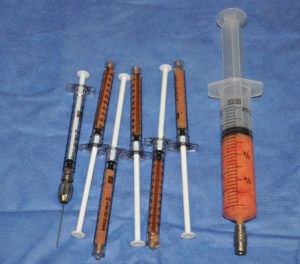
Despite all of these benefits fat injections suffer one major problem…they are unpredictable in terms of survival. It is known that fat injections are very technique-sensitive but an exact technical formula that works best is not yet known. The biology of fat graft survival is believed to that cell survival. In essence, the cell survival theory is based on the premise that some of the transplanted adipocytes survive and this accounts for the retained volume. Additional supposition is that the native stem cells in the fat graft also survive and can convert into adipocytes, further adding to volume retention. This biologic approach is why most current efforts focus on purifying and concentrating the fat prior to injection to maximize the number of living cells.
In the May 2012 issue of Plastic and Reconstructive Surgery, a study was published out of Japan entitled ‘ The Fate of Adipocytes After Non-Vascularized Fat Grafting….’ In this animal study, the different cells in a fat graft were evaluated after transplantation in mice for up to 14 days after surgery. Their study shows that the vast majority of fat cells die unless they are very close to a vascularized source known as the surviving zone which is very thin. (less than 300 microns) But the stem cells, known as adipose-derived stromal cells (ASCs), do survive in both this zone and the thicker layer known as the regenerating zone. Only in the center of the graft, known as the necrotic zone, do all cells die including the stem cells.
What this study suggests is that the cell survival theory for far grafts is not correct. Rather the host replacement theory is a better biologic answer. The value of stem cells or ASCs is really significant and it is their conversion to adipocytes that ultimate accounts for residual volume retention. This does not tell us, unfortunately how to maximize their survival, or more poignantly, to stimulate them after they are injected.
The host replacement theory may also support some of the speculative claims made by many of the most ardent proponents of injectable fat grafting. Beyond volume survival, they have been claimed to have regenerative activity that can stimulate tissue repair and rejuvenate skin quality. Numerous animal and clinical studies have shown a range of regenerative results from fat. These include improvements in skin color and texture and reductions in pore size and wrinkles. More impressively has been the positive changes in burn scars and better vascularization and skin quality of irradiated tissue beds.
It appears that every time fat is grafted, so are a certain number of stem cells. How to best stimulate them after injection may be the next advance in fat grafting.
Dr. Barry Eppley
Indianapolis, Indiana


